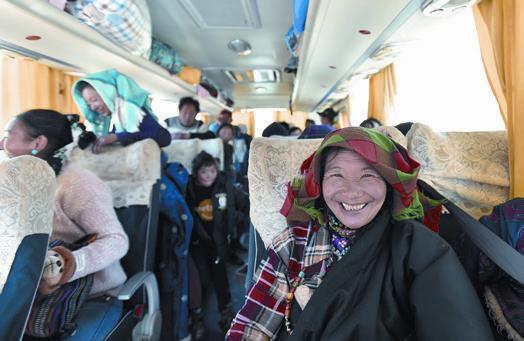HEADING FOR NEW HOME
2020-01-07


Fishing Season
Fishing boats cruise on Xingyun Lake in Yuxi, Yunnan Province in southwest China, on December 25, 2019, the day a fi shing ban on the lake was lifted. The fi shing season will last until January 23.
Renewable Energy
Effective enforcement of Chinas renewable energy law has boosted renewable energy utilization in the country and facilitated the rapid development of the sector, according to a report.
The report on the enforcement of the renewable energy law was submitted on December 24, 2019, to the bimonthly session of the National Peoples Congress (NPC) Standing Committee.
The power generated from renewable energy sources amounted to nearly 1.87 trillion kWh in 2018, accounting for 26.7 percent of Chinas total power output for the year, according to the report.
Ding Zhongli, Vice Chairman of the NPC Standing Committee, briefed lawmakers on the report at the second plenary meeting of the session.
An inspection of the enforcement of the law was carried out from August to November 2019. A total of 21 members of the NPC Standing Committee and the NPC Environmental Protection and Resources Conservation Committee, as well as national lawmakers, visited six provincial-level regions on inspection tours. Twelve provincial-level legislatures also inspected law enforcement efforts in their jurisdictions.
Agencies under the State Council have issued over 100 regulations and policies related to the law to foster a good policy environment for the development of renewable energy. Local regulations have also been formulated based on local conditions, according to the report.
As stipulated by the law, a thorough investigation into the endowment of renewable energy resources was carried out. An atlas of Chinas solar energy resources and an assessment of the countrys wind energy resources were issued in 2008 and 2014, respectively. Relevant State Council agencies have also rolled out fi ve-year plans for the development of renewable energy.
Major stipulations of the law have been implemented, the law has been effectively enforced and the purpose of the legislation has been fulfi lled, Ding said.
Housing Renovation
Chinas housing authorities pledged to speed up efforts to renovate dilapidated rural houses on December 23, 2019, as the deadline to eradicate absolute poverty by 2020 approaches.
China will ensure that renovation work on 1.35 million dilapidated rural homes will be completed in 2020, Wang Menghui, Minister of Housing and Urban-Rural Development, said at a work conference.
By the end of November 2019, construction had begun on 97.9 percent of the target homes, according to Wang.
Since the 18th National Congress of the Communist Party of China, the country has supported 17.94 million rural households in renovating their homes, and improved garbage and sewage treatment, bringing continuous improvements to the rural living environment.
In 2020, the government will continue to focus on enhancing housing conditions and the living environment in rural areas, further building new types of rural homes and accelerating garbage treatment, Wang said.
At the annual Central Economic Work Conference held in December 2019, poverty reduction was designated as one of the “three tough battles” for the country in 2020.
Digital Governance
Digital transformation has become a new engine for advancing the modernization of Chinas governance, according to a report from the Chinese Society for Urban Studies.
In the past four years, about 600 million users accessed urban services through Alipay, a Chinese third-party payment platform, to check their social insurance, pay for electricity, search for public transport and handle other matters.
China is in a leading position in the development of mobile payment and e-government services, said Song Junde, a professor at the Beijing University of Posts and Telecommunications.
The report by the Chinese Society for Urban Studies graded Chinese cities based on their levels of digitalization, with Hangzhou, Zhejiang Province in east China, ranking fi rst, followed by Shanghai and Wuhan, Hubei Province in central China.
Second-tier cities are narrowing the gap with f rist-tier cities in digitalization, especially in the areas of urban governance and public services, the report showed.
The competition between cities can strengthen the role of digitalization in fostering economic and social development and the modernization of Chinas national governance system and capacity, Song said.
All-Out Efforts
Rescuers transfer a survivor of a fl ooding accident at the Shanmushu coal mine owned by Sichuan Coal Industry Group in Gongxian County of Yibin City, Sichuan Province in southwest China on December 18, 2019.
The accident occurred on December 14, 2019, when 347 miners were working underground. A total of 329 escaped, while fi ve were killed. All the 13 missing miners were rescued after being trapped for over 80 hours in the mine.

Model Veterans
Chinese authorities honored 19 individuals and a veteran volunteer group as the countrys “veterans of the year” on December 24, 2019.
The veterans were recognized for their roles in leading scientifi c research, poverty alleviation and providing charitable services , according to the Publicity Department of the Communist Party of China Central Committee, the Ministry of Veterans Affairs and the Political Work Department of the Central Military Commission.
Initiated in 2001 by four veterans, the volunteer group in Jiangsu Province, east China, has offered fi nancial aid to more than 100 elderly disabled military personnel and members of the Red Army. It currently has 52 veteran members.
Shi Guangzhu, who was honored as a “combat hero” after joining the Peoples Liberation Army in 1981, has continued to help people with disabilities and families of martyrs since his retirement from the armed forces in 2005.
Li Jianchuan, born in 1966, has solved several technical problems in unmanned aerial vehicles since he left the armed forces. His inventions have been put into use in fi refi ght- ing, water rescue operations and counterterrorism operations.
The veterans received certifi cates, and the videos of their meritorious work were displayed at the ceremony.
Health Progress
Health authorities in Xinjiang Uygur Autonomous Region, northwest China, announced on December 21, 2019, that the region had eliminated malaria, following the completion of a state appraisal examining the regions 19-year-old clean bill of health.
Mard Abdurahm, Director of the Disease Control and Prevention Department of the regional health commission, said Xinjiang had reported no local malaria infection cases for 19 consecutive years.
The last case was recorded in August 2000, when a farmer in Aksu Prefecture was infected.
Malaria elimination is a national public health action carried out by the Chinese Government in response to the United Nations Millennium Development Goals and the World Health Organizations Malaria Elimination Initiative.
Abdurahm said the malaria elimination work in Xinjiang has received strong support from the Central Government. From 2011 to 2019, more than 10.73 million yuan($1.5 million) was invested to boost malaria prevention and control in the region.
He said epidemiological investigations into 48 malaria cases in Xinjiang from 2011 to 2019 confi rmed that they were all infections carried from outside the region.
The malaria elimination assessment in Xinjiang was made by a team of experts from the National Health Commission, the National Immigration Administration and the General Administration of Customs in early December 2019. Yan Jun, head of the team, said the evaluation team agreed that Xinjiangs malaria prevention and control work had met all the national requirements and passed the malaria elimination evaluation.
Malaria was prevalent in Xinjiang for many decades, with the 1950s and 1960s the main epidemic periods.
Lighting the Festival
A worker makes a lantern in a fl ower expo park in Yinchuan of Ningxia Hui Autonomous Region, northwest China, on December 24, 2019. The giant lanterns are for the upcoming local festival season starting December 31, 2019 and lasting until February 9, 2020.

Financial Services
A new guideline was unveiled on December 26, 2019 for banking and insurance institutions on utilizing financial services to stabilize foreign trade.
The document was jointly released by the China Banking and Insurance Regulatory Commission, the Ministry of Commerce and the State Administration of Foreign Exchange.
Greater efforts will be made to further regulate foreign traderelated business of the banking and insurance sectors, it said.
The guideline listed 29 specific requirements, including deepening reform, diversifying product types and strengthening background checks.
It also urged banking and insurance institutions to increase support for foreign trade-related businesses in terms of the management system, resource allocation and capacity building.
Banks are encouraged to boost the integrated development of domestic and foreign trade, Chinese and foreign currency businesses, and domestic and foreign operations, in a bid to satisfy the needs of fi rms engaged in foreign trade to organize production in China, the guideline said.
Growing Output
The Tarim oilfi eld branch of PetroChina, Chinas largest oil and gas producer, said they have produced over 28 million tons of oil equivalent of crude oil and natural gas in 2019.
The output, which was about 1.76 million tons more than that of 2018, included about 5.67 million tons of crude oil and about 28.05 billion cubic meters of natural gas, according to the company.
The oilfi elds output is expected to reach 30 million tons of oil equivalent by 2020 and 36 million tons by 2025.
Located in Xinjiang Uygur Autonomous Region, northwest China, Tarim Basin is the largest petroliferous area in the country and one of the most difficult to explore due to its harsh ground environment and complex underground conditions.
As Chinas third largest onshore oil and gas producer, the natural gas output of the Tarim Oilfi eld accounted for one sixth of the countrys total domestic gas output
The company said natural gas from the oilfi eld has benefi ted about 400 million residents in over 120 cities and more than 3,000 enterprises.

A Bridge, an Expressway and a Province
An aerial view of the Hanjiang River Bridge of the Zaoyang-Qianjiang Expressway in Hubei Province, central China, on December 20, 2019. The construction of the 244-km-long expressway is almost complete, and will have a running speed of 100 km per hour, shortening the travel time between northern and southern Hubei.
Smart Economy
Artifi cial Intelligence (AI) is no longer a thing of the future known only to professionals in China. People from all walks of life, both young and old, are enjoying the benefi ts of the growing smart economy.
After PCs, and mobile and PC Internet, the growth focus of Chinas digital economy is shifting to smart technologies like AI, Baidu Chairman and CEO Robin Li said at the World Internet Conference in October 2019.
In the smart economy era, Li predicted a declining reliance on cellphones and a rising popularity of other smart devices. AI chips and cloud computing services, among others, will become the new digital infrastructure, while innovative businesses will fl ourish as transport, health, education and other sectors go smart.
Wearable devices, smart home appliances, autonomous driving and smart cities are among the fastest growing fi elds of the smart economy.
China is the largest smart speaker market in the world, accounting for 36 percent of global shipments in the third quarter of 2019, according to global market fi rm Strategy Analytics. In a July and August survey, it found that 63 percent of Chinese people polled that didnt have a smart speaker planned to buy one within the year. Another 22 percent planned to make a purchase further out.
Chinese fi rms are stepping up investment in 5G, AI and the Internet of Things to gain a foothold in the emerging fi eld. By the end of June 2019, China had over 1,200 AIrelated enterprises, according to the Ministry of Industry and Information Technology.
Baidu launched its autonomous driving open platform Apollo in 2017 to coordinate cross-sector efforts in this f eild. It has launched several Level 4 autonomous driving vehicles in partnership with leading automobile companies, and a f leet of Apollo-powered “robotaxis” are now making test runs in Changsha, Hunan Province in central China.
Nurturing a smart economy is also on the government agenda. In 2019, China passed a guideline to boost the integration of AI and the real economy, and plans to build some 20 national AI innovation development pilot zones by 2023.
The countrys AI sector is forecast to be worth more than 160 billion yuan($22.8 billion) in 2020, spurring related sectors to exceed 1 trillion yuan ($143 billion), Lin Nianxiu, Deputy Director of the National Development and Reform Commission said, citing industrial data.
He added that China will focus on 100 fi rms dedicated to AI technologies and relevant applications, improve the industrial ecosystem, facilitate the deep integration of AI and the real economy, and intensify its international collaboration on AI technology, standards, industries, laws and regulations, as well as ethics.
Thriving Trade
A worker unloads red wine imported from Europe at the Yiwu Bonded Logistics Center in Yiwu City, Zhejiang Province in east China, on December 20, 2019.
According to customs statistics, the total import and export value of Yiwu from January to November 2019 was 265.76 billion yuan ($37.93 billion), which exceeded the total import and export value of 2018.

Winter Tourism
Winter sports enthusiasts can now feast on hotpot while skiing in northwest Chinas Xinjiang Uygur Autonomous Region.
The popular Chinese spicy dish is now being served at the ice and snow festival of hotpot as part of the regional winter tourism celebrations in Urumqis Baiyun Ski Resort.
As the Beijing 2022 Winter Olympic Games are approaching, Xinjiang, with abundant ice and snow resources, has seized the opportunity to promote winter tourism in recent years.
A variety of activities, including ice sculpture exhibitions, snow
marathons and football matches on ice now beckon tourists to discover the delights of winter in Xinjiang.
More distinctive souvenirs have also been developed to cater to tourists.
“Products with ethnic features are great souvenirs and gifts,” according to Gao Jie, a visitor to the just-concluded 14th Xinjiang Winter Tourism Trade Fair, which presented over 1,000 award-winning souvenirs.
“I used to purchase fruits and snacks as souvenirs, but now I have more options,” Gao added.
To further boost winter tourism, a total of 41 preferential policies have been rolled out in 11 cities in the region, including discounts for scenic spots and plane tickets.
The number of tourists to Xinjiang during winter has risen signifi cantly thanks to these efforts. Until 2006, only about 900,000 tourists visited the region during winter per year, but as of 2018, the fi gure surged to more than 30 million.
5G Phones
Smartphone shipments will rise in 2020, buoyed by the increasing popularity of 5G phones, according to global market intelligence fi rm International Data Corp. (IDC) on December 16, 2019.
Shipments of smartphones in China are estimated to edge up 0.7 percent year on year in 2020, as 5G phones spread across the market and give hesitant consumers the final nudge to switch models, said the IDC.
It expects 5G phone shipments to lead 5G network users in the short term, while one in every fi ve phones will be connected to the faster and more stable network by 2021.
Prices of more than 20 percent of 5G phones will dip below the 2,000 yuan ($285) mark next year, according to the IDC.
IDC data showed shipments of 5G phones in China reached 485,000 units in the third quarter of 2019, most of which were fl agship models priced at over $700.
Job Creation
The tertiary industry made impressive job gains with growing percapita revenue, the Fourth National Economic Census showed.
At the end of 2018, the number of employees in the wholesale and retail sectors was 40.08 million, up 20.9 percent from 2013, according to the National Bureau of Statistics.
The accommodation and catering sectors had 7.06 million employees in 2018, up 2.1 percent from 2013.
In addition, the per-capita turnover of the wholesale and retail sectors was 2.2 million yuan($314,555) in 2018, increasing by 19.1 percent from 2013.
During the same period, the per capita turnover of the accommodation and catering sectors rose 27 percent to 193,000 yuan ($27,640).

Life in Bloom
A farmer tends fl owers in a greenhouse in Guangxinzhuangzi Village of Tangshan, Hebei Province in north China, on December 19, 2019. Facility agriculture has become a new highlight in rural revitalization in Fengrun District, where local farmers are encouraged to grow produce such as strawberries, fl owers and mushrooms, and build agricultural sightseeing and selfservice picking gardens.
